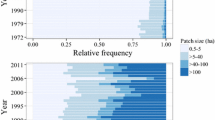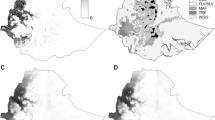Abstract
Context
Wildfire activity in boreal forests is projected to increase dramatically in response to anthropogenic climate change. By altering the spatial arrangement of fuels, land-cover configuration may interact with climate change to influence fire-regime dynamics at landscape and regional scales.
Objectives
We evaluate how land cover interacts with weather conditions to influence boreal-forest burning from 2012 to 2014 in Alaska.
Methods
Using geospatial fire and land-cover data, we quantify relationships between area burned and land cover, and test whether observed patterns of burning differ from random under varying weather conditions and fire sizes.
Results
Mean summer moisture index was correlated with annual area burned (ρ = −0.78, p < 0.01), the total number of fires (ρ = −0.68, p = 0.01), and the number of large fires (>500 km2; ρ = −0.58, p = 0.04). Area burned was related positively to percent cover of coniferous forest and woody wetlands, and negatively to percent cover of shrub scrub, dwarf scrub, and open water and barren areas. Fires preferentially burned coniferous forest, which represented 50.1 % of the area burned in warmer/drier summers and 40.3 % of area burned in cooler/wetter summers, compared to the 34.5 % (±4.2 %) expected by random selection of land-cover classes. Overall vegetation tended to burn more similarly to random in warmer/drier than cooler/wetter years.
Conclusions
Land cover exerted greater influences on boreal fire regimes when weather conditions were less favorable for forest burning. Reliable projections of boreal fire-regime change thus require consideration of the interactions between climate and land cover, as well as feedbacks from land-cover change.







Similar content being viewed by others
References
Ali AA, Carcaillet C, Bergeron Y (2009) Long-term fire frequency variability in the eastern Canadian boreal forest: the influences of climate vs local factors. Global Change Biol 15(5):1230–1241
Allen RG, Pereira LS, Raes D, Smith M (1998) Crop evapotranspiration—guidelines for computing crop water requirements—FAO irrigation and drainage. Food and Agriculture Organization of the United Nations, Rome, Report nr 56
Balshi MS, McGuirez AD, Duffy P, Flannigan M, Walsh J, Melillo J (2009) Assessing the response of area burned to changing climate in western boreal North America using a multivariate adaptive regression splines (MARS) approach. Global Change Biol 15(3):578–600
Barrett CM, Kelly RF, Higuera PE, Hu FS (2013) Climatic and land-cover influences on the spatiotemporal dynamics of Holocene boreal fire regimes. Ecology 94:389–402
Bessie WC, Johnson EA (1995) The relative importance of fuels and weather on fire behavior in subalpine forests. Ecology 76(3):747–762
Beyer HL (2004) Hawth’s analysis tools for ArcGIS [computer program]. Available from http://www.spatialecology.com/htools. Accessed Sep 2015
Bond WJ, Keeley JE (2005) Fire as a global ‘herbivore’: the ecology and evolution of flammable ecosystems. Trends Ecol Evol 20(7):387–394
Bond-Lamberty B, Peckham SD, Gower ST, Ewers BE (2009) Effects of fire on regional evapotranspiration in the central canadian boreal forest. Global Change Biol 15(5):1242–1254
Brubaker LB, Higuera PE, Rupp TS, Olson M, Anderson PM, Hu FS (2009) Linking sediment-charcoal records and ecological modeling to understand causes of fire-regime change in boreal forests. Ecology 90(7):1788–1801
Colombaroli D, Gavin DG (2010) Highly episodic fire and erosion regime over the past 2000 years in the Siskiyou Mountains, Oregon. Proc Natl Acad Sci USA 107(44):18909–18914
Cumming S (2001) Forest type and wildfire in the Alberta boreal mixedwood: what do fires burn? Ecol Appl 11(1):97–110
Dansereau PR, Bergeron Y (1993) Fire history in the southern boreal forest of northwestern Quebec. Can J Forest Res 23(1):25–32
Dissing D, Verbyla DL (2003) Spatial patterns of lightning strikes in interior Alaska and their relations to elevation and vegetation. Can J Forest Res 33:770–782
Duffy PA, Walsh JE, Graham JM, Mann DH, Rupp TS (2005) Impacts of large-scale atmospheric-ocean variability on Alaskan fire season severity. Ecol Appl 15(4):1317–1330
Flannigan MD, Logan JA, Amiro BD, Skinner WR, Stocks BJ (2005) Future area burned in Canada. Clim Change 72:1–16
Flannigan MD, Krawchuk MA, Groot WJD, Wotton BM, Gowman LM (2009) Implications of changing climate for global wildland fire. Int J Wildland Fire 18:483–507
Gavin DG, Brubaker LB, Lertzman KP (2003) An 1800-year record of the spatial and temporal distribution of fire from the west coast of Vancouver Island, Canada. Can J Forest Res 33(4):573–587
Gedalof Z, Peterson D, Mantua N (2005) Atmospheric, climatic, and ecological controls on extreme wildfire years in the northwestern United States. Ecol Appl 15(1):154–174
Girardin MP, Ali AA, Carcaillet C, Blarquez O, Hely C, Terrier A, Genries A, Bergeron Y (2013) Vegetation limits the impact of a warm climate on boreal wildfires. New Phytol 199(4):1001–1011
Grimm EC (1984) Fire and other factors controlling the big woods vegetation of Minnesota in the mid-19th century. Ecol Monogr 54(3):291–311
Hellberg E, Niklasson M, Granstrom A (2004) Influence of landscape structure on patterns of forest fires in boreal forest landscapes in Sweden. Can J Forest Res 34(2):332–338
Heyerdahl EK, Brubaker LB, Agee JK (2001) Spatial controls of historical fire regimes: a multiscale example from the interior west, USA. Ecology 82(3):660–678
Higuera PE, Brubaker LB, Anderson PM, Hu FS, Brown TA (2009) Vegetation mediated the impacts of postglacial climate change on the fire regimes in the south-central Brooks Range, Alaska. Ecol Monogr 79(2):201–219
Hogg E (1997) Temporal scaling of moisture and the forest-grassland boundary in western Canada. Agric Forest Meteorol 84(1–2):115–122
Homer C, Dewitz J, Fry J, Coan M, Hossain N, Larson C, Herold N, McKerrow A, VanDriel JN, Wickham J (2007) Completion of the 2001 national land cover database for the conterminous United States. Photogramm Eng Remote Sens 73(4):337–341
Homer C, Dewitz J, Yang L, Jin S, Danielson P, Xian G, Coulston J, Herold N, Wickham J, Megown K (2015) Completion of the 2011 national land cover database for the conterminous United States—representing a decade of land cover change information. Photogramm Eng Remote Sens 81(5):345–354
Hu FS, Brubaker LB, Gavin DG, Higuera PE, Lynch JA, Rupp TS, Tinner W (2006) How climate and vegetation influence the fire regime of the Alaskan boreal forest biome: the Holocene perspective. Mitig Adapt Strateg Global Change 11:829–846
IPCC (2013) Climate Change 2013: The Physical Science Basis. Contribution of Working Group I to the Fifth Assessment Report of the Intergovernmental Panel on Climate Change [Stocker TF, Qin D, Plattner G-K, Tignor M, Allen SK, Boschung J, Nauels A, Xia Y, Bex V and Midgley PM (eds.)]. Cambridge University Press, Cambridge. doi:10.1017/CBO9781107415324
Johnson EA (1992) Fire and vegetation dynamics: studies from the North American boreal forest. Cambridge University Press, Cambridge
Johnstone JF, Rupp TS, Olson M, Verbyla D (2011) Modeling impacts of fire severity on successional trajectories and future fire behavior in Alaskan boreal forests. Landscape Ecol 26(4):487–500
Kasischke ES, Turetsky MR (2006) Recent changes in the fire regime across the North American boreal region—spatial and temporal patterns of burning across Canada and Alaska. Geophys Res Lett 33(9):L09703
Kasischke ES, Williams D, Barry D (2002) Analysis of the patterns of large fires in the boreal forest region of Alaska. Int J Wildland Fire 11(2):131–144
Kasischke ES, Verbyla DL, Rupp TS, McGuire AD, Murphy KA, Jandt R, Barnes JL, Hoy EE, Duffy PA, Calef M, Turetsky MR (2010) Alaska’s changing fire regime—implications for the vulnerability of its boreal forests. Can J Forest Res 40(7):1313–1324
Kelly R, Chipman ML, Higuera PE, Stefanova I, Brubaker LB, Hu FS (2013) Recent burning of boreal forests exceeds fire regime limits of the past 10,000 years. Proc Natl Acad Sci USA 110(32):13055–13060
Kelly R, Genet H, McGuire AD, Hu FS (2015) Palaeodata-informed modelling of large carbon losses from recent burning of boreal forests. Nat Clim Change. doi:10.1038/NCLIMATE2832
Kolden CA, Lutz JA, Key CH, Kane JT, van Wagtendonk JW (2012) Mapped versus actual burned area within wildfire perimeters: characterizing the unburned. Forest Ecol Manag 286:38–47
Larsen CPS (1997) Spatial and temporal variations in boreal forest fire frequency in northern Alberta. J Biogeogr 24(5):663–673
Lloret F, Calvo E, Pons X, Diaz-Delgado R (2002) Wildfires and landscape patterns in the eastern Iberian Peninsula. Landscape Ecol 17(8):745–759
Lu J, Sun G, McNulty S, Amatya D (2005) A comparison of six potential evapotranspiration methods for regional use in the southeastern United States. J Am Water Resour Assoc 41(3):621–633
Lutz HJ (1956) Ecological effects of forest fires in the interior of Alaska. Alaska Forest Research Center: USDA Forest Service. USDA Technical Bulletin 1133
Mann DH, Rupp TS, Olson MA, Duffy PA (2012) Is Alaska’s boreal forest now crossing a major ecological threshold? Arct Antarct Alp Res 44(3):319–331
McGarigal K, Cushman SA, Neel MC, Ene E (2002) FRAGSTATS: Spatial pattern analysis program for categorical maps [computer program]. University of Massachusetts, Amherst. Available from http://www.umass.edu/landeco/research/fragstats/fragstats.html (accessed September 2015)
Miller C, Urban DL (2000) Connectivity of forest fuels and surface fire regimes. Landscape Ecol 15(2):145–154
Moritz M, Morais M, Summerell L, Carlson J, Doyle J (2005) Wildfires, complexity, and highly optimized tolerance. Proc Natl Acad Sci USA 102(50):17912–17917
Overpeck J, Webb T, Prentice I (1985) Quantitative interpretation of fossil pollen spectra— dissimilarity coefficients and the method of modern analogs. Quat Res 23(1):87–108
Parisien M, Parks SA, Miller C, Krawchuk MA, Heathcott M, Moritz MA (2011) Contributions of ignitions, fuels, and weather to the spatial patterns of burn probability of a boreal landscape. Ecosystems 14(7):1141–1155
Parks SA, Parisien M, Miller C (2011) Multi-scale evaluation of the environmental controls on burn probability in a southern Sierra Nevada landscape. Int J Wildland Fire 20(7):815–828
Rogers BM, Soja AJ, Goulden ML, Randerson JT (2015) Influence of tree species on continental differences in boreal fires and climate feedbacks. Nat Geosci 8:228–234
Rupp TS, Starfield AM, Chapin FS (2000) A frame-based spatially explicit model of subarctic vegetation response to climatic change: comparison with a point model. Landscape Ecol 15(4):383–400
Rupp T, Starfield A, Chapin F, Duffy P (2002) Modeling the impact of black spruce on the fire regime of Alaskan boreal forest. Clim Change 55(1–2):213–233
Selkowitz DJ, Stehman SV (2011) Thematic accuracy of the national land cover database (NLCD) 2001 land cover for Alaska. Remote Sens Environ 115(6):1401–1407
Senici D, Chen HYH, Bergeron Y, Cyr D (2010) Spatiotemporal variations of fire frequency in central boreal forest. Ecosystems 13(8):1227–1238
Soja AJ, Tchebakova NM, French NHF, Flannigan MD, Shugart HH, Stocks BJ, Sukhinin AI, Parfenova EI, Chapin FS III, Stackhouse PW (2007) Climate-induced boreal forest change: predictions versus current observations. Global Planet Change 56(3–4):274–296
Turner MG, Romme WH (1994) Landscape dynamics in crown fire ecosystems. Landscape Ecol 9(1):59–77
Yarie J (1981) Forest fire cycles and life-tables—a case-study from interior Alaska. Can J Forest Res 11(3):554–562
Acknowledgments
This research was supported by NSF grant ARC-0612366 (F. S. Hu) and a Dissertation Completion Fellowship from the Graduate College of the University of Illinois (C. B. Dash). We thank Melissa Chipman, Daniele Colombaroli, Philip Higuera, Ryan Kelly, Robert Scheller, and David Verbyla for insightful comments.
Author information
Authors and Affiliations
Corresponding author
Electronic supplementary material
Below is the link to the electronic supplementary material.
Rights and permissions
About this article
Cite this article
Dash, C.B., Fraterrigo, J.M. & Hu, F.S. Land cover influences boreal-forest fire responses to climate change: geospatial analysis of historical records from Alaska. Landscape Ecol 31, 1781–1793 (2016). https://doi.org/10.1007/s10980-016-0361-2
Received:
Accepted:
Published:
Issue Date:
DOI: https://doi.org/10.1007/s10980-016-0361-2




